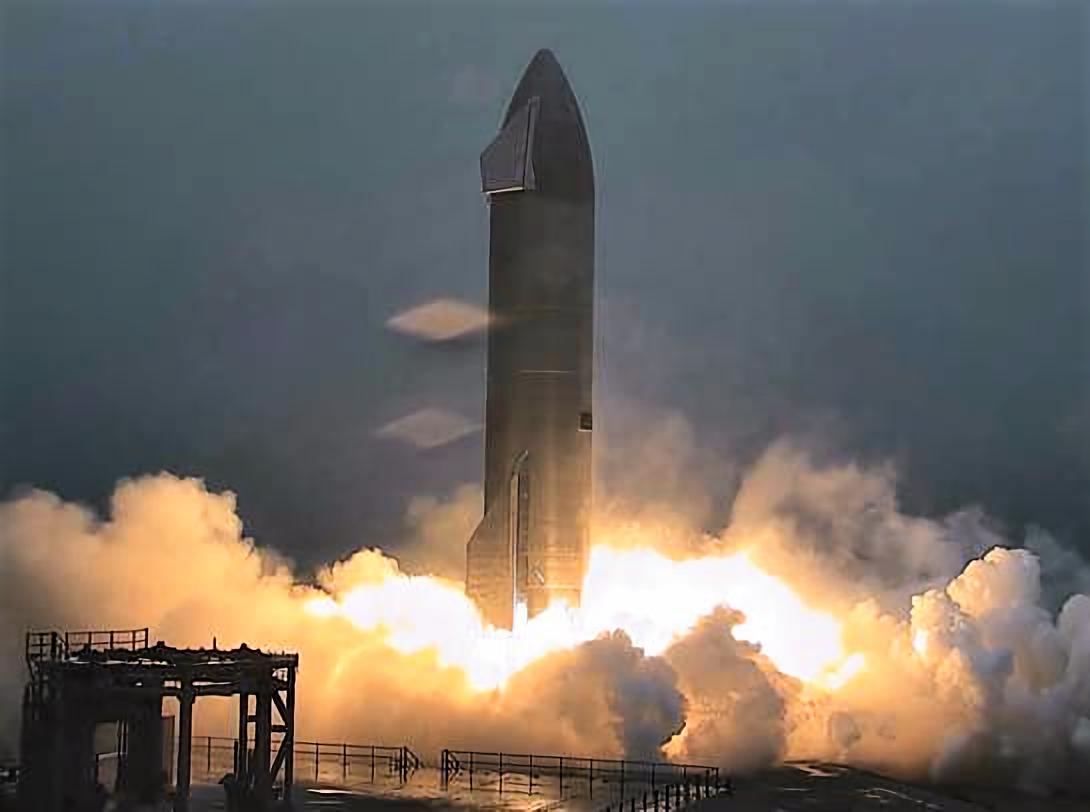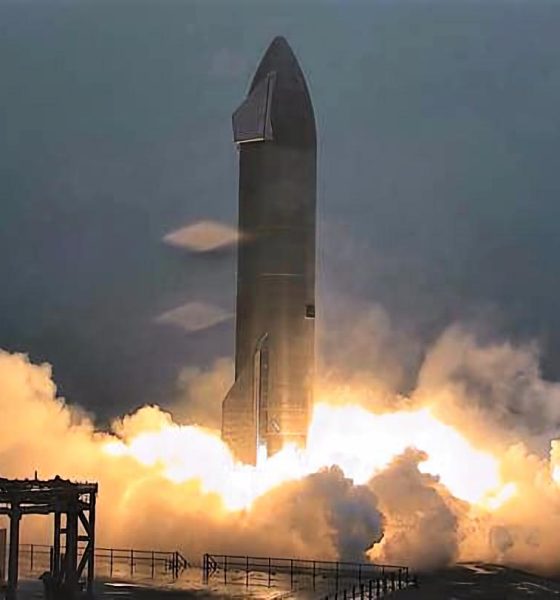

News
High winds scrub SpaceX Starship SN9’s Monday launch attempt
Update (2:30 pm CST): SpaceX appears to have called off Monday’s Starship SN9 launch attempt due (primarily) to high winds along the flight corridor. Additional opportunities are available from 8 am to 6 pm CST (UTC-6) on Tuesday (Jan 26) and Wednesday (Jan 27).
Technically, lacking any official confirmation, there’s still a chance of a launch attempt or additional ground testing happening today but either possibility is extremely unlikely at this point.
Update: SpaceX has completed what is known as a Flight Readiness Review (FRR) and determined that Starship prototype SN9 is ready to attempt its first high-altitude launch as early as today.
All necessary aviation and maritime notices and restrictions are in place and the company has begun the process of closing a public highway and clearing the launch site of employees. Today’s (Jan 25) launch window lasts from noon to 6 pm CST (UTC-6) and Starship SN9 could likely be made ready to launch anytime after 2pm be ready to fly as early as 4 pm CST according to a loudspeaker announcement at the launch pad. Stay tuned for updates and, hopefully, an official SpaceX webcast.
All signs point to SpaceX’s second high-altitude Starship prototype preparing for a 12.5-kilometer (~40,000 ft) as early as Monday, January 25th in a bid to rectify a last-second bug that caused its predecessor to explode last month.
Known as Starship serial number 8 (SN8), the SpaceX-built prototype was the first to have its basic airframe (tank and nose sections) fully integrated, as well as the first Starship to attempt to break the 150m (~500 ft) ceiling set by Starhopper, SN5, and SN6. Break the ceiling SN8 most certainly did, performing a spectacularly successful 12.5 km launch that aced almost every single goal SpaceX had hoped to complete. Keyword almost.
After an impressive 280 seconds of uninterrupted operation of its Raptors, Starship SN8 shut down the last of those three engines, flipped onto its belly, and successful freefell ~12 kilometers back to Earth. The rocket then carried that success even further, reigniting two Raptors, performing a dramatic 120-degree flip, orienting itself vertically, and beginning to slow down for a soft landing.
Only then did Starship SN8’s performance deviate from virtual perfection. At T+6:38, a few seconds after beginning its crucial landing burn, one of Starship’s active Raptors shut down and the other effectively stopped generating thrust. The reason, CEO Elon Musk would later explain, was low head pressure in a smaller tank (‘header tank’) dedicated to supplying fuel during Starship’s wild flip and landing maneuver. It was never confirmed if the Raptor engine shutdown observed milliseconds prior to the other engine losing thrust was intentional.
Cause aside, the end result was unsurprising: without enough thrust to slow down, Starship SN8 accurately impacted the concrete landing zone but did so at high speed – likely around 50-60 m/s (100-150 mph). Given that Starhopper and Starships SN5 and SN6 had already successfully proven Starship’s ability to gently land from 150 meters on a single Raptor engine and that, prior to SN8, Starship’s bizarre belly-flop descent and 90-degree flip had been almost entirely theoretical, SpaceX deemed the launch a spectacular success.
Nothing better exemplifies that than the fact that a little over a month later, SpaceX quite literally began scrapping the most complex, completed section of a future Starship prototype (SN12) before it ever reached the assembly phase. Instead, SpaceX appears to be more focused than ever on a mysterious series of “major” upgrades Musk has said will debut on Starship SN15. Nearly all SN15 subsections have been completed and are simply waiting to be joined together, while parts of SN16 and SN17 are also starting to pile up in staging areas.
Starship SN10 is practically ready to move to the launch pad to prepare for flight as soon as SpaceX chooses to do so and Starship SN11 is likely no more than a week or two of work away from reaching same level of readiness.
Ultimately, despite a long and delay-ridden test campaign, Starship SN9 finally completed what looked like a full-duration static fire of all three of its Raptor engines – the rocket’s sixth static fire overall. On Saturday, January 23rd, SpaceXers installed SN9’s flight termination system (FTS) – a system of explosives designed to destroy Starship if it flies too far off course. For Starship, FTS installation all but guarantees that a launch attempt is a matter of days away. Fresh county roadblocks, Temporary Flight Restrictions (TFRs) granted by the FAA, and Coast Guard a safety notice further imply that SN9 will attempt to launch as early as Monday morning, January 25th, with backup opportunities on Tuesday and Wednesday.
With any luck, like SN8’s high-altitude debut, SpaceX hopefully livestream Starship SN9’s own attempt at the same feat. Stay tuned for more details as they come.

News
Tesla starts showing how FSD will change lives in Europe
Local officials tested the system on narrow country roads and were impressed by FSD’s smooth, human-like driving, with some calling the service a game-changer for everyday life in areas that are far from urban centers.

Tesla has launched Europe’s first public shuttle service using Full Self-Driving (Supervised) in the rural Eifelkreis Bitburg-Prüm region of Germany, demonstrating how the technology can restore independence and mobility for people who struggle with limited transport options.
Local officials tested the system on narrow country roads and were impressed by FSD’s smooth, human-like driving, with some calling the service a game-changer for everyday life in areas that are far from urban centers.
Officials see real impact on rural residents
Arzfeld Mayor Johannes Kuhl and District Administrator Andreas Kruppert personally tested the Tesla shuttle service. This allowed them to see just how well FSD navigated winding lanes and rural roads confidently. Kruppert said, “Autonomous driving sounds like science fiction to many, but we simply see here that it works totally well in rural regions too.” Kuhl, for his part, also noted that FSD “feels like a very experienced driver.”
The pilot complements the area’s “Citizen Bus” program, which provides on-demand rides for elderly residents who can no longer drive themselves. Tesla Europe shared a video of a demonstration of the service, highlighting how FSD gives people their freedom back, even in places where public transport is not as prevalent.
What the Ministry for Economic Affairs and Transport says
Rhineland-Palatinate’s Minister Daniela Schmitt supported the project, praising the collaboration that made this “first of its kind in Europe” possible. As per the ministry, the rural rollout for the service shows FSD’s potential beyond major cities, and it delivers tangible benefits like grocery runs, doctor visits, and social connections for isolated residents.
“Reliable and flexible mobility is especially vital in rural areas. With the launch of a shuttle service using self-driving vehicles (FSD supervised) by Tesla in the Eifelkreis Bitburg-Prüm, an innovative pilot project is now getting underway that complements local community bus services. It is the first project of its kind in Europe.
“The result is a real gain for rural mobility: greater accessibility, more flexibility and tangible benefits for everyday life. A strong signal for innovation, cooperation and future-oriented mobility beyond urban centers,” the ministry wrote in a LinkedIn post.
News
Tesla China quietly posts Robotaxi-related job listing
Tesla China is currently seeking a Low Voltage Electrical Engineer to work on circuit board design for the company’s autonomous vehicles.

Tesla has posted a new job listing in Shanghai explicitly tied to its Robotaxi program, fueling speculation that the company is preparing to launch its dedicated autonomous ride-hailing service in China.
As noted in the listing, Tesla China is currently seeking a Low Voltage Electrical Engineer to work on circuit board design for the company’s autonomous vehicles.
Robotaxi-specific role
The listing, which was shared on social media platform X by industry watcher @tslaming, suggested that Tesla China is looking to fill the role urgently. The job listing itself specifically mentions that the person hired for the role will be working on the Low Voltage Hardware team, which would design the circuit boards that would serve as the nervous system of the Robotaxi.
Key tasks for the role, as indicated in the job listing, include collaboration with PCB layout, firmware, mechanical, program management, and validation teams, among other responsibilities. The role is based in Shanghai.
China Robotaxi launch
China represents a massive potential market for robotaxis, with its dense urban centers and supportive policies in select cities. Tesla has limited permission to roll out FSD in the country, though despite this, its vehicles have been hailed as among the best in the market when it comes to autonomous features. So far, at least, it appears that China supports Tesla’s FSD and Robotaxi rollout.
This was hinted at in November, when Tesla brought the Cybercab to the 8th China International Import Expo (CIIE) in Shanghai, marking the first time that the autonomous two-seater was brought to the Asia-Pacific region. The vehicle, despite not having a release date in China, received a significant amount of interest among the event’s attendees.
Elon Musk
Elon Musk and Tesla AI Director share insights after empty driver seat Robotaxi rides
The executives’ unoccupied tests hint at the rapid progress of Tesla’s unsupervised Robotaxi efforts.

Tesla CEO Elon Musk and AI Director Ashok Elluswamy celebrated Christmas Eve by sharing personal experiences with Robotaxi vehicles that had no safety monitor or occupant in the driver’s seat. Musk described the system’s “perfect driving” around Austin, while Elluswamy posted video from the back seat, calling it “an amazing experience.”
The executives’ unoccupied tests hint at the rapid progress of Tesla’s unsupervised Robotaxi efforts.
Elon and Ashok’s firsthand Robotaxi insights
Prior to Musk and the Tesla AI Director’s posts, sightings of unmanned Teslas navigating public roads were widely shared on social media. One such vehicle was spotted in Austin, Texas, which Elon Musk acknowleged by stating that “Testing is underway with no occupants in the car.”
Based on his Christmas Eve post, Musk seemed to have tested an unmanned Tesla himself. “A Tesla with no safety monitor in the car and me sitting in the passenger seat took me all around Austin on Sunday with perfect driving,” Musk wrote in his post.
Elluswamy responded with a 2-minute video showing himself in the rear of an unmanned Tesla. The video featured the vehicle’s empty front seats, as well as its smooth handling through real-world traffic. He captioned his video with the words, “It’s an amazing experience!”
Towards Unsupervised operations
During an xAI Hackathon earlier this month, Elon Musk mentioned that Tesla owed be removing Safety Monitors from its Robotaxis in Austin in just three weeks. “Unsupervised is pretty much solved at this point. So there will be Tesla Robotaxis operating in Austin with no one in them. Not even anyone in the passenger seat in about three weeks,” he said. Musk echoed similar estimates at the 2025 Annual Shareholder Meeting and the Q3 2025 earnings call.
Considering the insights that were posted Musk and Elluswamy, it does appear that Tesla is working hard towards operating its Robotaxis with no safety monitors. This is quite impressive considering that the service was launched just earlier this year.








